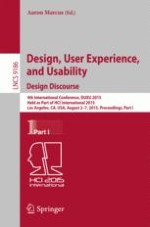2015 | OriginalPaper | Chapter
Scenario Analysis as a Tool for Informing the Design of Behaviour Change Interventions
Authors : Luis Oliveira, Martin Maguire, Val Mitchell, Andrew May
Published in: Design, User Experience, and Usability: Design Discourse
Publisher: Springer International Publishing
Activate our intelligent search to find suitable subject content or patents.
Select sections of text to find matching patents with Artificial Intelligence. powered by
Select sections of text to find additional relevant content using AI-assisted search. powered by
